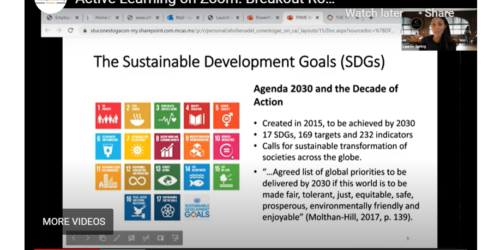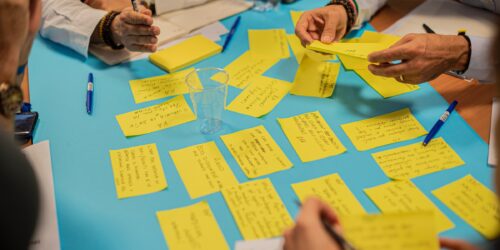How Collaboration Across Disciplines Can Spice Up Learning
By Martha Terdik, Chris Arsenault and Cheryl Williams
Martha Terdik teaches in the Bachelor of Public Relations Program (BPR). After a successful 25-year career in corporate communications, Martha enjoys mentoring the next generation of professional communicators.
Follow Martha on Twitter @marthaterdik.

Chris Arsenault is the coordinator of the Journalism program at Conestoga College.
Follow Chris on Twitter @chrisarsenaul.

Cheryl Williams is a full-time faculty member in the Bachelor of Public Relations program at Conestoga. Follow Cheryl on Twitter @cherylwilliams.

In higher education, we’re all languishing these days — students as well as teachers. And the prospect of a fall semester, either fully or partially online, doesn’t help. It’s time to change things up! One way to inject some energy, creativity and fun is to collaborate with courses in other areas. Here are five tips to managing successful collaboration initiatives:
Partner with areas of expertise.
For an Issues Management and Crisis Communications course, we wanted to assess how well students could apply what they had learned in real-time through a mock news conference. Rather than ask half the class to pretend they were reporters, members of the PR faculty reached out to a colleague who teaches in the journalism school.
The result was three half-hour mock news conferences. Communications students tested their abilities to develop and deliver key messages as spokespeople. Journalism students did what they do best: competing with each other to uncover the most compelling news angles, asking tough questions in the process.
When students don’t know each other, they will undertake the role-play more seriously. During the mock news conference, when one “company spokesperson” became uncomfortable with a reporter’s question and tried to move on, the “reporter” interrupted by exclaiming, “But you didn’t answer my question. Let’s continue.”
Combine evaluations.
In our mock news conference scenario, two colleagues joined forces on the public relations side. Martha Terdik taught Issues Management and Crisis Communication while Cheryl Williams taught Corporate Social Responsibility (CSR). A perfect fit! We developed CSR-related scenarios for each of the news conferences.
Since our students were the same for both courses, we developed joint evaluations with course-specific elements on the rubrics. Streamlining the assessment process went a long way to demonstrating support for stressed and overwhelmed students. Several students expressed their appreciation.

Organize for maximum participation.
Hosting three media conferences allowed us to assign small numbers of students to each scenario. With small groups, it’s challenging for anyone to “hide” or opt out of participating. If students weren’t participating as spokespeople, they were writing key messages. While groups waited for their turn, they observed the other news conferences taking notes based on specific prompts.
Create opportunities for fun.
We’ve experienced enough pandemic stress. Why not introduce some fun elements into the classroom? Our news conferences were based on actual events to ensure they were relatable and plausible in real life. Then, we added additional complexities and ethical considerations to keep the scenarios exciting and our students on their toes.
For example, one scenario involved a manufacturer that pivoted to making N-95-comparable masks during the pandemic. While the media gathered to herald the seemingly altruistic act, leaked emails suggested other, more self-serving ulterior motives. Our reporters especially enjoyed putting all of these pieces together.
Not all details were included in the scenarios. Roles were not pre-assigned. Communications students drew on frameworks and class discussions to determine spokesperson roles, subject matter experts, etc. Journalism students researched the scenarios to come up with smart and interesting story angles.
Wrap up with a debrief.
Initially, we were concerned about the challenges of hosting the news conferences over Zoom. This proved to be a non-issue. Since most media interviews are occurring over Zoom these days, it actually created a more authentic experience. Additionally, with Zoom’s recording capabilities, we watched the recordings with our students the following week during debrief sessions.
We were amazed by the insights our students expressed and how much they valued practicing their respective roles. Reporters and communications spokespeople often find themselves on opposite sides of the microphone. It’s a symbiotic relationship at best. When students learn from each other in this type of role-play, the skills they learn are invaluable.
Do collaborative activities require more work upfront? In our case, yes: we wrote and reviewed detailed scenarios for each news conference, and we met several times to develop and finalize logistical details. Was it worth the effort? A resounding yes – from the students as well as from our faculty team. We believe this practical learning experience will be one of the highlights in an otherwise difficult academic year.
Key takeaways for faculty:
- Leverage expertise by partnering with faculty from complementary programs.
- Develop joint evaluations with course-specific elements on each rubric.
- Organize students into small groups to maximize participation.
- Provide space for creative expression to boost the fun factor.
- Encourage students to reflect on their experience with a post-activity debrief.



